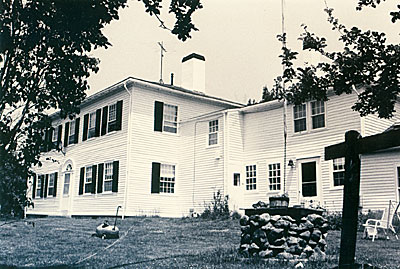 |
| The 1802 Federal Farmhouse at Carding Brook Farm in Brooklin houses a very modem organic farming couple, Jonathan Ellsworth and Jennifer Schroth. They specialize in growing small amounts of unusual produce, such as 25 varieties of tomatoes. |
Article & Photos by Jane Lamb
Picture a classic Federal country house on a saltwater farm bordering a tidal river, horses working the fields beyond a tree-shaded brook, sheep browsing in the orchard, hens cackling, geese honking, a friendly black Lab greeting arrivals. You’re back in the nineteenth century hobnobbing with contemporaries of Thoreau and Emerson in a bucolic, Currier and Ives calendar original.
Actually, you haven’t arrived by horse and buggy, or even more likely by schooner, but by car on Maine Route 175. You’re at Carding Brook Farm on the Benjamin River in Brooklin, where a decidedly twenty-first-century young couple are enjoying both worlds, but working just as hard as the farm’s founders, even with the help of many modern conveniences. Jonathan Ellsworth and Jennifer Schroth are figuring out how to make a living selling organic vegetables, along with assorted smaller enterprises, using draft horses and the occasional aid of an ancient Allis Chalmers tractor. Getting past that often-insurmountable roadblock – acquiring a farm in the first place – was relatively easy: It was in the family. The hard part is finding ways to maintain the big, handsome, two-story house and hold on to land that has wealthy suburbanites and eager developers drooling.
Jen’s grandfather, the late Russell Wiggins, a well-known journalist, public figure and publisher of the Ellsworth American, bought the property in the 1950s as a gentleman’s farm. Jen had come there summers since childhood. When the couple, who met at the College of the Atlantic (in Bar Harbor) graduated, they were at that stage where they weren’t sure what they wanted to do. “We knew we wanted to farm, but couldn’t figure out how,” Jen says. “We knew we’d never get enough money to buy our own land.” They were considering Aroostook County, where land is cheap. Then their big opportunity came 11 years ago, when the Wiggins’ caretaker wanted to retire. The couple had been living nearby, mowing lawns, doing odd jobs, when Jen’s grandparents offered them the job. “They needed someone to care for the land, and we got a great chance to start farming,” she relates.
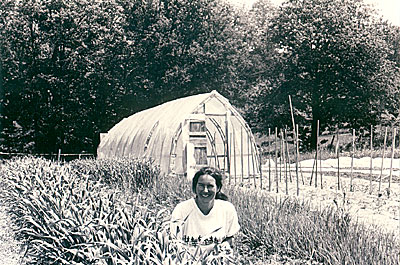 |
| Jennifer weeds leeks; a hoop house is used to raise tomatoes. |
Farmers’ Market Was the Answer
“I had never gardened or anything,” Jen continues, “but Jon grew up on a dairy farm in Farmington, so he knew how to run the tractor, and that was a big help. We just learned by doing it. We got our first horse that year. We farm with draft horses. The horse taught us and we taught him.”
Not only did they learn from the horse. “If you’re going to start farming,” says Jon, “there are a lot of key people you have to know. Unless you’re really handy, you have to find local people who can help you figure out the mechanical stuff you can’t do. Butch Byard is that person for us. We’re lucky because there are a lot of good farmers around here – Dennis King, Paul Birdsall, Paul Volckhausen. They kind of paved the way. We watch them and learn from them.” Jen and Jon consider themselves the second wave coming up behind these veterans. It took the couple a while to work themselves into what they now believe is the right niche.
They inherited a flock of fancy, pure-bred Suffolk sheep from Jen’s grandfather. That has dwindled to a flock of 10, now mostly Romney, with a little bit of Jacob. The sheep help to keep the lawns and back fields mowed and fertilized, and they are certainly picturesque. Jen would like to start spinning, if she could find the time. They also have about 30 laying hens and sell eggs to the neighbors. They switched to organic feed last year. “Hopefully, it’s worth the price,” says Jen. “I think we’re going to be able to get it wholesale from Hancock Organic Growers [HOG]. That would make it more worthwhile. Someone made the point that if you get organic grain, you’re not buying all that GMO corn to feed them. I think it’s worth trying for a while. It’s a nice feeling knowing you’re eating organic eggs.” They started raising turkeys just for themselves and are considering raising enough to sell so that they can pay for the organic grain.
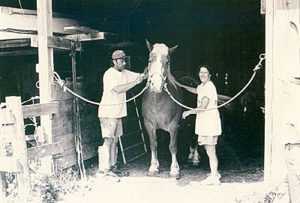 |
| Jon and Jen harness Shy, their 10-year-old Belgian mare. |
Organic hay is a different matter. It’s not available locally, one reason they wouldn’t want to raise certified organic meat animals. The hay they cut is “just Downeast hay,” Jon says. He’s hoping to grow some organic oats to feed the horses and sheep. “It would be nice to get to the point where we were kind of a [self-sufficient] closed circle.” As for the geese, a leftover from earlier days, they’re good watch animals and a source of entertainment. Tough and long-lived, they take shelter in the barn only when the pond freezes over. “We give them a little corn and don’t bother them,’ Jon says. “They do get in the garden a little, so we have to watch them. They know. They’ll look right at you and then get out. We don’t mind them as long as they’re not ripping up the broccoli.” The couple raise a few lambs for their own freezer, but no meat animals for market, except possibly the turkeys. As Jon notes, the sheep are mostly pets, like their other animals, even the horses. “We really figured the numbers,” Jen says,” and you can make more money selling peas than lamb.” Which is just what they decided to do.
When they started going to the Blue Hill Farmers’ Market and saw what the bigger farmers were selling, they tried to do something different. They have only 4 acres tilled up in the small plots typical of saltwater farm topography. “Part of our whole deal was smaller amounts of things that are kind of unusual,” says Jen. “That became our little niche, to be well displayed and as perfect as possible. We’ve capitalized on that. We seem to get certain customers who respond well to that kind of thing.” They try to offer a full spectrum of summer vegetables: lots of varieties of peas and beans; cool weather crops such as potatoes, broccoli, garlic, onions, shallots, leeks; and 25 varieties of tomatoes, including heirlooms, which they plant in black plastic mulch in a hoop house. They make a specialty of salad greens, which they wholesale to six or seven restaurants in the area and retail at the Blue Hill and Deer Isle farmers’ markets. “You can get head lettuce everywhere,” Jen notes, “but selling mixtures of strange kinds of greens at a time when mesclun was becoming popular just took off. You can get $8 a pound for the mixture.” They are trying to add strawberries to their inventory. (We sampled some of the Sparkle, the only variety to grow around there, according to their friend, Butch. He’s right. They were delicious.) This year, their 300 plants produced plenty for home consumption, but not enough to offer a steady supply for sale. They could just see running out of strawberries with a long line of customers waiting, and as Jon points out, “We really try to take care of our farmers’ market customers.” They’ll be expanding their strawberry production and have put in 500 raspberry plants. A well-established 600-foot asparagus bed will be supplying the stand next spring.
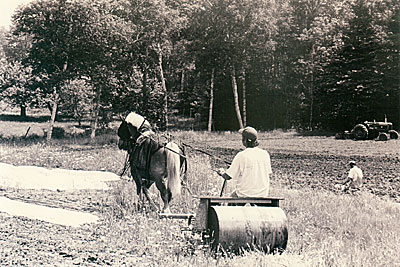 |
| A cultivator/roller at work. In the background, apprentice Abigail Lyman picks potato bugs. |
The farmers’ market is a great way for young farmers to get a start and test the market, they believe, citing new ones springing up in Calais and Eastport for example. “There’s a lot of room for them to grow around here,” says Jon. “Abigail, our apprentice, and Brian Olson, the guy who worked for us last year, came to this area to farm but are nervous because there were so many good farms around here, and where would they find a market? I don’t think that’s the case.”
“Any young farmer who is really committed to farming and makes a commitment to find a market, fill it, work with restaurant chefs or go to the farmers’ market, anyone who really wants to do it, could make it, if they can get the land, “Jen adds.
Jon believes that many year-round residents, as well as the summer population, are really looking to buy local, organically grown food. Some new farmers join the Hancock (County) Organic Growers (HOG) and sell at the coop farm stand, but “We’re really desperate for some young farmers at our farmers’ market,” he says. They have put ads in the paper inviting them to join the Blue Hill Farmers’ Market. They’ve called all the young farmers they know. “We know they’re out there, but they’re reluctant to dive in.” Farmers’ markets seem to flourish along the Maine coast, with its growing retirement community and its abundance of summer residents and visitors, while they don’t work for areas of sparse population, such as the County, as Jim and Megan Gerritsen have learned. (The MOF&G, September-November 2001). But Jen Schroth and Jon Ellsworth have discovered one thing in common with the Gerritsens.
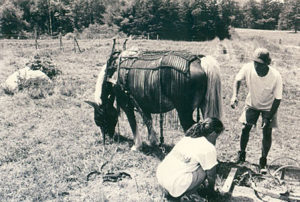 |
| Jon and Jen hitch up the harrow-roller rig, while Shy, in complete fly regalia, relaxes. |
Direct Selling Works Best
“We belonged to HOG in the beginning, but we decided it wasn’t the best way for us to sell our stuff,” Jen says. “I like having direct contact with our customers.” Even though it’s among friends, the co-op is still a middleman. Eliminating that step becomes direct retailing, and all the income goes to the farmer. The Gerritsens’ solution was direct mail. Jen’s and Jon’s was direct retail sales to customers at the farmers’ markets.
It was hard for them to participate in the co-op, they say. The first year, when one of them had to work one afternoon or morning a week, they managed, but the next year, when things got tight trying to make the HOG farm stand go, someone had to work one whole day a week. “We just couldn’t do it,” Jen recalls “We’d just had our first child and we were really trying to make a go of farming. Someone was working, someone was at home with the baby and no one was on the farm. It drove us crazy and we had to drop out.” They missed seeing the other farmers and being part of the group, but the change has worked for them. “Our whole thing of growing small amounts of unusual things doesn’t lend itself to having someone else sell them. We found we really needed to sell them ourselves, talk to the chefs, talk to people at the farmers’ market, tell them how great fava beans are, how to cook them. The co-op just wasn’t the right venue for us.”
Jon says that when Jen first started going to market he stayed home doing “important stuff like hay and God knows what. I didn’t want to go and didn’t for four or five years. I never got that feedback. Finally she said ‘You’re going to market. I need help.’ She was overwhelmed, so I went and I love the feedback. It makes you want to go home and make sure you put effort into the garden in a different way. And it’s not just the money. Money’s great; it’s good to make it. But also, people really enjoy your stuff and want to see you come. They ask for things you might have had last year.” One of his favorite moments is when native Mainers buy their new potatoes and say, “That’s what a potato used to taste like. It’s great.” When Jon’s father, who sold the dairy farm years ago for health reasons, comes to visit, he keeps asking, “Have you dug your potatoes yet? Are they ready yet?” Though Jon is glad to go to the farmers’ market, he also enjoys coming home and hiding a bit. “I’m a farm boy,” he admits. “I don’t like to see a lot of people. Farming to me is a hideout.” The couple toyed only briefly with the idea of a farm stand at home. “If people come over, you have to give a tour, stop and talk for an hour.” He’d rather be farming.
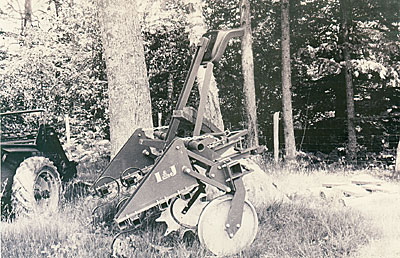 |
| A bright red, brand new, Amish-built, two-horse cultivator awaits a new team. |
Managing the Gardens
Carding Brook Farm’s crops grow on 4 tilled acres surrounded by open fields that slope southwestward to the Benjamin River. The farm road leads downhill from the house and crosses the brook over a wooden bridge beside the dam that creates a small pond, to arrive at the farmyard with its machinery and horse sheds. The pond and an old dug well supply water for irrigation, employed when necessary to ensure steady production of salad greens, their biggest cash crop. “We figured out an irrigation system that we add to every year,” Jon explains: “overhead sprinklers with pipe we have to drag around. It’s pretty labor intensive but pretty cheap. We don’t have a lot of drip line. If you run a lot of drip line out and try to cultivate with a horse, you make a mess.”
Three Carding Brook acres are planted in vegetables and another acre in potatoes. Jon and Jen sell a lot of new potatoes in mixed varieties. “One thing we try to push is getting things early for market, especially the salad greens, because we rely on the farm income,” Jen says. They raise their own seedlings. “We’re going to start doing greens in the hoop house, but we’re not going to try to go through the winter. We’re so burned out by October. We might try to keep a few greens going for ourselves till Christmas, and maybe pick up again in March. It’s great picking our own salad then. But we don’t want to heat the hoop house. Eliot Coleman lives in the next town over, and he can do winter greens all he wants!” Their location, in the sea-tempered fog zone, extends the season a week or two on both ends. If they make it past the first frost in late September, they may produce almost to Halloween. “Sometimes that’s a bad thing,” says Jon. “You’re begging for frost to end it!”
The couple are constantly looking for new ideas. “It’s funny,” Jon says, “how you see and read about stuff and get really excited. You have to pay attention to everybody around you and try to figure out what works best for you. You can’t be like every other farmer, but you can pick up bits and pieces.” They were particularly interested in what the Nordells, from Pennsylvania, had to say about weed control and nutrient building at the Farmer to Farmer Conference. [See The MOF&G, March-May 2001, page 18.] Weeds are a bigger problem for them than insect pests. “Half [the Nordells’] land is out [of production] in fallow and cover crops. The other half is cash crop, so they’re only marketing half their land at a time,” Jon points out. “We don’t have quite enough land in cultivation for that, but we rotate everything every year. We’re trying to get half the land out of cultivation. It’s something to work towards.” Meanwhile, they use lots of compost and regularly till up and replant fallow beds in their endless battle against weeds. Nothing does this job for them better than horses.
Farming with Horses
Jon and Jen bought their first draft horse, a Belgian, 11 years ago. Chub is now 25 and retired. His teammate, Shy, a Belgian mare, is ten. She’s learning to work as a single horse, which neither of the team is very happy about. They expect Shy to help them train their new team, Jay and Jackson, three-year-old Suffolk half-brothers. They’re not as big as Belgians, but are known to be good farm horses, with a calm temperament. “They’re really keyed into people,” Jon reports. “The other night when we had that big thunderstorm, they got out. I thought they were going to be running through the gardens, but they came right up to me.”
“I always liked animals,” he continues. “I loved being around them on the farm. I wanted to be a wildlife biologist, to study about wolves and coyotes, but I’m really much happier around horses.” However, he admonishes, you have to like horses. “The only reason to work with horses is because you really like them. You can argue economics, they’re good on the soil, and all that, but if you don’t like a horse to work around, don’t go near it. The Amish work with horses but there are some Amish who hate them and wish they could use a tractor.” Being fond of their horses is only part of the story for Jon and Jen. One of the biggest advantages is that they can get onto their heavy clay soil as much as two weeks earlier in the spring. “You can take horses out on the clay when it’s really heavy and cultivate with a spring-tooth harrow to start drying out the top. The horses get pretty muddy, but the tractor would get stuck.”
Jon doesn’t know if they’ll ever get rid of the tractor, however. Horses are not practical for most of their haying, which they do on nearby small farms. They haven’t enough hay land of their own to supply their winter needs. “When we had our good team, we did almost everything in the garden with horses. What happened this year is that our spacing is set up for horse equipment and the tractor isn’t compatible. It’s been a bit of an issue. The mare is a good horse, but there’s too much cultivation for one horse. We couldn’t get everything done this spring.”
“We used to work the mesclun beds with a rototiller,” Jen says, “but we want to get away from the rototiller. I don’t like the way it pulverizes the soil too much. It ruins the soil structure.” They’ve minimized the use of the tiller and have been using a single-horse bed-preparer that Jon contrived, a spring-tooth harrow with a roller behind it. “If you’re fallowing and nothing’s planted, you can just run this thing through every week. It will chop the weeds and turn the organic matter in. You can flatten the bed for replanting a new crop of mesclun.” Waiting for the new team to be trained is a brand-new, two-horse cultivator they purchased from an Amish company. “We only got to run it through the gardens a couple of times because we were pushing the old guy hard and he was really sore. We finally decided Chubby had to retire. He’s OK now. He can move around, but he can’t work hard. He was the best at making straight rows for planting. We really haven’t had a chance to use this machine. It’s a great rig. We tried to figure out how to use it with the tractor but it doesn’t work very well.” The Amish make one with a three-point hitch for a tractor, but Jon was surprised that the tractor model costs more than the horse-drawn one, even though the latter is more complex.
Winter in the Woods with Horses
Jon and Jen have their own woodlot, but they seldom get to it because they have too many orders for cleaning up a few trees around a house or working a small, private woodlot. “This is our fifth year,” Jon says, “and we’ve learned a lot. We can see that it has the potential to be successful, but what happens in the wood business in Maine is whoever gets the wood roadside fastest sets the market price. If you go in with a three-person crew and a feller, a buncher and a grapple skidder, you’re putting 1,590 cords of wood roadside a day. They’re flooding the market, setting a low price.
“We usually have two single horses working, sometimes a team,” Jon continues. “We have to trailer them to the job site. I can’t see taking a horse to stand around while I’m cutting.” He lays down a lot of wood one day. The next day he and Jen work separately with the two horses to haul it out. Chub still gets a chance to work once in a while twitching small logs. “We’ve learned there are right ways and the wrong ways to work the woods with horses. We have to be brutally frank with ourselves and the customer as to what we can do. Horses are really slow compared with mechanical equipment, but horses can do things in the woods that nothing else can. We can do a lot of little jobs – a week or two weeks – but we’re not going to one big woodlot and staying there. There’s no point in competing on the big, commercial level.” To do that with horses you have to cut every tree, no matter what the quality,” he says.
“What I like to do is look at a tree and say, ‘Should this one come out? How am I going to get it down with the least damage?’ There’s no time for that if you’re going to make money cutting wood. If you’re standing there looking at a tree, you’d better cut it. You almost have to clearcut. I like to cut a lot of wood. I can make a big mess, make a big pile of wood with horses. Jen has had to rein me back to do a good job, tree by tree. That’s what the people we work for want to see.”
Jen sees it a little like organic farming. “There’s a good way to do it and people are getting interested in the good way. Wood is a renewable resource. It’s not really valid to say never cut trees down. We all use wood products. The key is to try to figure out the right way to do it.” They have been working with Danny Weed, a neighbor who uses a tractor. With the horses, they get logs to a point where he can cable them out in a straight line with very low impact on the forest.
“When you drag a cable off a tractor or skidder, unless you have a snatch block to guide the log here and there, it’s a straight line between where the log is and the machinery. The log is going to scrape off or run over everything that’s in between,” Jon explains. “With a horse, the log tracks right behind his hind feet. We can twitch logs out with little damage, zigzagging around corners, to where he [Danny Weed] can get a straight shot with a cable winch off the tractor. We’re working around some pretty expensive houses. He thinks it’s quicker than him doing all that cable work. If you go through a horse lot, you can’t see any straight lines. There’s a lot of things you can’t do with a horse, though. You can’t chip up limbs. You can’t lean a tree up and hook a skidder to it and haul it down. You have to take time and be careful.”
When work in the woods is slow, Jon still does some carpentry, but he’s doing that less and less. In March, it’s time to make maple syrup. He and Jen don’t have a sugar bush, but they tap about 150 hundred-year-old trees along driveways and farm fields. Such trees produce the maximum amount of sap because, being in the open, they have big canopies of leaves, where sap with the highest concentration of sugar is produced. They make 60 to 95 gallons of MOFGA-certified syrup a year from about 200 taps – another item for the farmers’ market.
A Long History
As far as Jen knows, the big, white house dates from 1802, but her uncle told her that a smaller cape might have been there a lot longer and been replaced by the Federal farmhouse after a fire. The farm’s name comes from Carding Brook, which runs through the property. A carding mill was once farther upstream, an indication that sheep were an important part of the early economy. Quite a settlement of Europeans may have inhabited the area. “When my grandfather bought the place, it was just a field as far as we can see,” Jen says. “He bought two or three little pieces of property, smaller farms. There are old foundations and walls all over. He thought there used to be strawberries farmed here. There are a lot of wild strawberries. We haven’t discovered any Indian relics, but it looks like a place they’d use, right at the head of the river with lots of streams flowing into it.”
Now that her grandfather has died (November, 2000), Jen and Jon are trying to figure out how they can keep the place as a farm that will support itself. “We know how fortunate we are,” says Jen. “There aren’t many of these old saltwater farms left. We’re probably going to have to get some kind of farmland easements, one of those Blue Hill Heritage Trust things. We’re still looking into it. Right now we’re kind of nervous about this. It’s great to live on the farm with our kids, but farmers don’t have this kind of house.” They have two boys, Nolan, 6 and Walker, two.
Jon agrees that being a carpenter will help a lot with the maintenance of a 200-year-old house with its 11 rooms, ells and attached sheds. “But it’s going to have to be a month or two a year of maintenance time,” he says. “Where do I get paid for that?” He and Jen are trying to work toward “homesteading,” that is, closer and closer to a self-sustaining operation. They see Dennis King as a role model. “He’s a scientist. He’s always working on his one little thing, seeing if it works. If it doesn’t, he doesn’t get locked into it. He’s not afraid of change.” Jon and Jen are a couple whose willingness to keep trying something new is matched by their enthusiasm and their obvious enjoyment of what they’re doing, despite the difficulties. “We’re gaining,” says Jon, “but I really feel I know less than I did 10 years ago. I know how much I don’t know. I’m not sure we’re in a position to offer advice. Come back in 10 years.”
